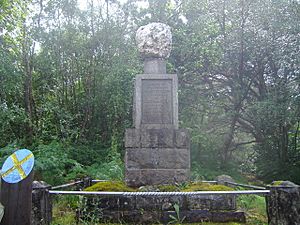James Stewart of the Glen facts for kids
Quick facts for kids
James Stewart of the Glen
|
|
|---|---|

Seamus a'Ghlinne memorial cairn
|
|
| Born | c. 1698 |
| Died | 8 November 1752 |
| Cause of death | Hanging |
| Nationality | Scotsman |
| Other names | James of the Glens Seamus a’ Ghlinne James Stewart of Acharn |
| Criminal charge | Accessory to Murder |
| Penalty | Capital punishment |
James Stewart of the Glen (in Gaelic: Seumas a' Ghlinne), born around 1698 and who died on November 8, 1752, was an important leader of the Clan Stewart of Appin in Scotland. He was also known as James of the Glens. He was sadly accused and hanged for being involved in a famous crime called the Appin Murder. He always said he was innocent.
Contents
The Appin Murder and James's Trial
What Was the Appin Murder?
On May 14, 1752, a man named Colin Roy Campbell was shot from behind. He was a government factor, which means he managed lands that had been taken from Scottish clans who had supported the Jacobite Rising of 1745. This was a big rebellion where people tried to put a different king on the throne.
Why Was James Stewart Accused?
After the murder, people started looking for the killer among the Clan Stewart. This was because Colin Campbell had forced many members of Clan Stewart off their lands. The main person suspected of the shooting, Alan Breck Stewart, ran away.
Because Alan Breck Stewart had fled, James Stewart of the Glens was arrested. James was a leader of the Stewarts, sometimes called their tanist, meaning he was next in line to lead the clan.
The Trial and Its Outcome
James Stewart's trial was very unfair. The powerful Clan Campbell controlled it. The main judge was Archibald Campbell, 3rd Duke of Argyll, who was the chief of the Campbells. Also, all 15 people on the jury were from the Campbell clan.
Even though the trial showed that James was not directly involved in the murder – he had a strong alibi (proof he was somewhere else) – he was still found guilty. He was found guilty of being an "accessory," meaning he helped or encouraged the crime, even if he didn't do it himself.
James's Execution
How James Died
James Stewart was hanged on November 8, 1752. His execution happened on a special gallows built high above the narrows at Ballachulish. This spot is now near the south entrance of the Ballachulish Bridge.
James died saying he was innocent. He hoped that people in the future would never think he was capable of such a terrible murder. To this day, people in the Scottish Highlands still remember his last words as "The Psalm of James of the Glens."
Why His Body Was Left Hanging
After his death, James's body was left hanging for 18 months. It was at the south end of the Ballachulish Ferry. This was meant to be a warning to other clans who might think about rebelling against the government. Over time, his body was damaged by the wind and rain. Eventually, his bones were held together only by chains and wire.
James Stewart's Legacy
Efforts to Clear His Name
Even today, there are efforts to get a pardon for James of the Glens. A pardon means officially forgiving someone for a crime and clearing their name.
In 2008, a lawyer from Glasgow named John Macaulay asked the Scottish Criminal Cases Review Commission to look at James's case again. This commission reviews old criminal cases. Macaulay believed that after studying the trial records, there was "not a shred of evidence" against James Stewart.
However, the commission said no. They felt the case was too old to be reviewed in a way that would be fair to everyone involved. As of 2010, the request to pardon James Stewart is still being considered by the Scottish Ministers.

